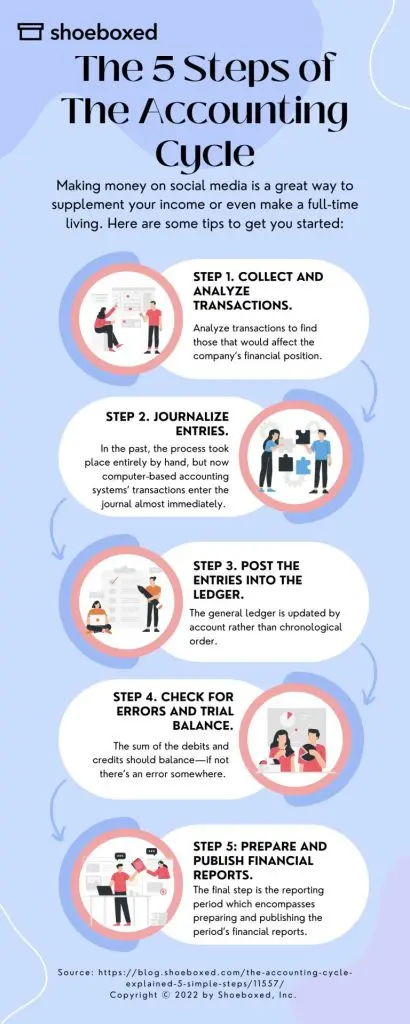Financial statements are the very backbone of every business. Information contained in these statements is crucial for making decisions, planning expenses, securing loans, and even selling the business. But the question is, just how are these financial statements generated?
A multistep process called the accounting cycle assists in taking all the raw financial data from a business and converting it into financial statements. Whether you are an accountant or bookkeeper, following the accounting cycle’s 5 steps will help companies remain compliant and transparent regarding their financial health.
What is the accounting cycle?
The accounting cycle is the process that involves identifying, analyzing, and recording a company’s accounting data in an effort to produce consistent and accurate financial statements. Essentially, this multistep process ensures that all of the money that passes through the business is accounted for correctly.
Accounting cycle definition by Alanis Business AcademyWhy is the accounting cycle important?
Large and small businesses benefit from implementing the accounting cycle to collect and organize financial data. Businesses without a full-time accounting department, such as mom-and-pop stores, rely on each step to maintain financial accounting methods that stick to their budget while giving them a clear picture of their financial situation.
Apart from streamlining the financial accounting process, the accounting cycle provides an efficient way to meet compliance requirements, internal analysis processes, and time management with a focus on the fiscal year.
A company using the accounting cycle will also gain a general ledger used to determine current balances and assist in finding past transactions. Additionally, knowing the accounting cycle and other small business accounting tips can simplify your business operations.
What are the 5 steps in an accounting cycle?
To quickly summarize, the five steps in the accounting cycle include: collecting and analyzing transactions, journalizing the entries, posting the entries into the ledger, checking for errors and trial balance, and lastly, the reporting period.
Step 1. Collect and analyze transactions.
The first step of the accounting cycle analyzes transactions to find those that would affect the company’s financial position. The analysis finds transactions that alter the company’s financial position, such as any of the following:
Revenue earned
Customer cash payments
Asset purchases
Expenses
Borrowing
Sale closing
Accounts receivable
Bad debt write-offs
Dividends declared
Be sure to know what can count as a business write-off.
Never lose a receipt again 📁
Join over 1 million businesses scanning receipts, creating expense reports, and reclaiming multiple hours every week—with Shoeboxed.✨
Get Started TodayThe larger the company, the more transaction types are possible—though small businesses also find bountiful transactions to log.
Step 1 in the accounting cycle by ProfAlldredge.Step 2. Journalize entries.
In the past, the process took place entirely by hand, but now computer-based accounting systems’ transactions enter the journal almost immediately. Point-of-sale systems are a good accounting cycle example concerning how quickly and efficiently journal entries are entered into the accounting journal the instant the sale takes place.
Journal entries hold debits and credits in chronological order allowing businesses to reference the system should a question arise. In addition, the transactions will have the date, amount, and location for future reference.
Step 3. Post the entries into the ledger.
As mentioned above, journal entries get entered into the system chronologically or in the order in which they happen. However, the general ledger, updated in Step 3, is done by account rather than in chronological order. Accounts refer to how the business buckets transactions such as cost of goods sold, investments, taxes paid, and many others.
This general ledger becomes the master key, so to speak. Anyone within the company can use the general ledger to find the company’s current balance. It also becomes the fastest way to find any transaction through the accounts listed in the general ledger by first narrowing down to which account the transaction belongs.
Step 4. Check for errors and trial balance.
The fourth step occurs at the end of the accounting period, where an unadjusted trial balance is created. This is done by balancing credits and debits in one place, such as a table, which follows the double-entry accounting philosophy. The sum of the debits and credits should balance, or else there will be an error in the data entered.
If any accounting errors are found, the accounting cycle calls for a reconciliation to be performed to ensure all transactions balance. Temporary adjusting accounts help accountants restore balance in the debits and credits while providing more time to find the error. The entire exercise calls to find errors, correct the errors, and close temporary adjusting accounts, all before the end of the trial balance period.
Step 5: Prepare and publish financial reports.
The final step in the accounting cycle is the reporting period which encompasses preparing and publishing the period’s financial reports. Since the reports disclose all transactions through the last day of the period, such information is published after the accounting period is closed. Therefore, the time between the last day of the cycle and the day all financial statements are published is closed may vary in length.
Governments and other regulatory bodies made four different statements mandatory:
The income statement
The balance sheet
The statement of changes in the financial position
The statement of retained earnings
Public companies must take the extra step and obtain an auditor’s opinion on the financial statements before publishing the information to avoid misleading the public and other stakeholders. This opinion doesn’t explain the company’s financial position but rather whether the financial statements meet all requirements, such as following generally accepted accounting principles.
Frequently asked questions
What are the 5 steps in the accounting cycle?
The five steps in the accounting cycle are as follows:
1. Collecting and analyzing transactions.
2. Journalizing the entries.
3. Posting the entries into the ledger.
4. Checking for errors and trial balance.
5. Preparing and publishing reports.
Why is the accounting cycle important?
Large and small businesses benefit from implementing the accounting cycle to collect and organize financial data. Businesses without a full-time accounting department, such as mom-and-pop stores, rely on each step to maintain financial accounting methods that stick to their budget while giving them a clear picture of their financial situation. Apart from streamlining the financial accounting process, the accounting cycle also provides an efficient way to meet compliance requirements, internal analysis processes, and time management with a focus on the fiscal year.
Break free from paper clutter ✨
Use Shoeboxed’s app and scanning service to scan receipts and organize your wallet and office. Try free for 30 days!
Get Started TodayInfographic: The accounting cycle’s 5 steps

The Accounting Cycle’s 5 Steps
In closing
Large and small companies adhere to the accounting cycle to efficiently keep track of all transactions that impact their financial position. The five steps of the accounting cycle lead accountants from determining which transactions belong on the ledger to publishing financial statements.
As the accounting cycle is followed, transactions are written down in the journal chronologically before getting updated on the general ledger in the appropriate company account. The accounting cycle is an important step in finding errors should transactions not balance correctly before any financial statements are published.
Most importantly, the accounting cycle helps companies comply with government bodies and stakeholders. However, public companies must take the extra step and find an outside auditor who determines whether all steps were followed correctly.
Small businesses might find the steps tedious, but they are important all the same. Whether the financial transactions deal in the millions or only thousands, the accounting cycle should be followed with diligence and integrity.
To hone your bookkeeping skills so you can accurately monitor the financial health of your company, check out our mammoth list of 45+ bookkeeping resources!
Agata Kaczmarek has held a passion for writing since early childhood. A professional writer for many years, Agata specializes in writing articles and blogs focused on finance as someone who holds a Master’s Degree in Accounting and Finance.
About Shoeboxed!
Shoeboxed is a receipt scanning service with receipt management software that supports multiple methods for receipt capture: send, scan, upload, forward, and more!
You can stuff your receipts into one of our Magic Envelopes (prepaid postage within the US). Use our receipt tracker + receipt scanner app (iPhone, iPad and Android) to snap a picture while on the go. Auto-import receipts from Gmail. Or forward a receipt to your designated Shoeboxed email address.
Turn your receipts into data and deductibles with our expense reports that include IRS-accepted receipt images.Join over 1 million businesses scanning & organizing receipts, creating expense reports and more—with Shoeboxed.
Try Shoeboxed for FREE now!



